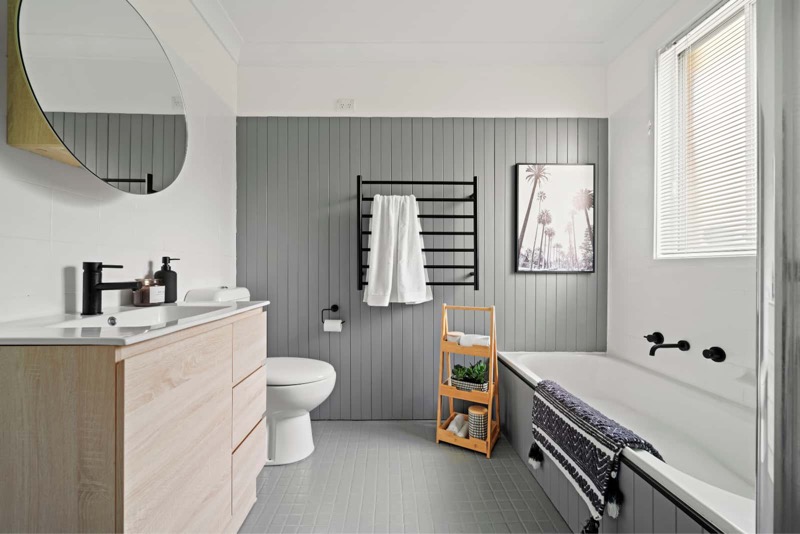Renovating a bathroom is an exciting yet daunting challenge. As one of the most expensive rooms in the house to overhaul, it’s important to get it right the first time.
A successful design is far more than meets the eye – and this all comes down to research and planning into the layout of your bathroom. Once you’ve got the layout nailed down, you can move on to the fun stuff.
But, where do you start? Here are some top tips for planning your bathroom layout.
1. Seek inspiration
The best place to start when it comes to renovating any room in your home is to get some inspiration.
Checking out home interior blogs and social media platforms such as Pinterest and Instagram can help to give you a real feel for the type of style and layout you’re looking for. You never know, you might just come across an idea that had never crossed your mind before.
Pick and choose any particular elements, colour schemes or smart storage solutions that you particularly like and go from there. Don’t be too concerned with how the size of your bathroom compares at this point, as there’s plenty of time to adjust for functionality – and you may just be surprised what you can fit into a small bathroom!
2. Consider your bathroom needs
Bathrooms have different specifications for layouts and functionality depending on how they will be used. A guest bathroom and the main bathroom for a family of four may require different fixtures and fittings, for example.
Take into account the size of the bathroom and how many people will be using it. Do you want to create a relaxing, romantic en-suite for two? A simple walk-in shower room for your guests? Or a spacious environment with plenty of storage for bath toys?
All of these considerations impact how many fixtures and fittings will be needed, and how the layout will need to be arranged.
3. Measure your space
Now it’s time to be realistic, and figure out how much space you have for the facilities you’d like in your bathroom.
Carefully and accurately measure your floor space, and take into account any features that may impact the design space i.e. windows, doors, sloping walls and alcoves.
Then, you’ll want to size up any furniture you’ve had your eye on and insert them into that space. Play around with different layouts and arrange the furniture in a layout that works. It’s important to be realistic here, and ensure there is plenty of space between fixtures and fittings.
If your desired outcome isn’t quite working, it might be time to bring it back to square one and re-adjust your preferences. Consider opting for smaller furniture, or removing additional items that aren’t completely necessary. Remember, a bathroom should be functional and practical first and foremost.
4. Don’t overlook storage
Storage in a bathroom is a need rather than a must. The key to a well-designed bathroom is one that serves all purposes, and that includes keeping it clean and tidy without overwhelming the space with unnecessary clutter.
A built-in vanity storage unit is a fantastic solution to hiding away all of your toiletries and adding space to store extra towels and essentials. Consider factoring in a little more room for your sink area if this is the case.
If your bathroom space doesn’t allow for this, seek out smart storage solutions that can be neatly tucked into a corner and take into account the space you’ll need for that in order to avoid your bathroom looking cluttered in between fixtures and fittings.
5. Carefully consider your colour palette
The colour scheme you choose for your bathroom has a huge impact on how the space turns out, so take some time to settle with a theme that you love.
If you’re not an avid renovator and are looking for your bathroom to last for years to come, don’t be too quick to jump on the in-trend that may die out quickly before you re-decorate. Stick to a minimalistic colour scheme and opt for a classic white bath, toilet, shower and tiles.
This way, you can re-invent the look more frequently by accessorising with different coloured luxury towels and switching them up to match seasonal trends.
6. Prioritise your budget
The key to a successful bathroom renovation is being smart with your budget. Once you’ve finalised the budget you’re able to spend, figure out what aspects of the bathroom are the most important to you.
Whether this is a freestanding bath or a rainfall shower, be sure to take this into account and spend your money wisely in these areas. This may mean making a compromise on other areas of your bathroom, but it can be easier than you think to overspend so bear this in mind.
Lastly, your dream bathroom doesn’t have to cost a fortune. You want to be careful not to invest more money than you’ll likely gain back if you come to sell in the future, so be mindful of this and budget wisely for both the practical and stylish elements.




